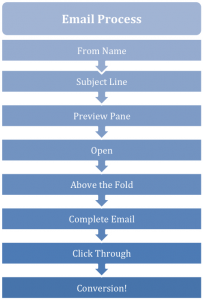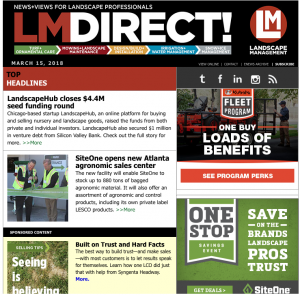Danielle Pesta
Senior Digital Media Manager
Danielle Pesta has a bachelor’s degree in journalism and media communications from Otterbein University. At North Coast Media, she manages the digital media team as well as the digital strategy for LP Gas. She has been in B2B publishing since 2014 and has won multiple awards from the Turf and Ornamental Communicators Association and the American Society of Business Publication Editors.
Year: 2018
NCM’s Kelly Limpert named top young leader by ASBPE

CLEVELAND – April 16, 2018 – North Coast Media (NCM) is proud to announce Digital Media Content Producer Kelly Limpert has been awarded a Young Leaders Scholarship from the American Society of Business Publication Editors (ASBPE).
Limpert will receive her award at the Azbee Awards of Excellence Banquet May 10, 2018 at The National Press Club in Washington, D.C.
Originating in 2001, the Young Leaders Scholarship is awarded to five of the country’s top business editors under 30 each year. The scholarship will fund Limpert’s attendance at the ASBPE National Conference, which is held in conjunction with the awards banquet.
“Kelly is a skillful videographer and video editor, with an eye for what works and an innate creative ability to make something out of nothing. I’ve been impressed many times by her technical proficiency. Kelly has a very distinctive editorial voice; you can tell a Kelly-tweet from an everyone-else-tweet. The same goes for her blog and feature writing,” says NCM Director of Audience Engagement, Bethany Chambers. “Kelly is a dedicated employee and one of the hardest workers you’ll meet. When she takes on a project, she sets out to be the best at it and has the persistence to see that through. I admire that tenacity and I am glad she’s brought that here to our team.”
Limpert is responsible for developing content for the digital properties of NCM’s Landscape Management, Golfdom and Athletic Turf brands. She also assists with video coverage of the brands and multi-media production, often traveling to tradeshows and client events to develop content for publication.
“In her role as digital content producer, she has proven to be an excellent teammate who is always willing to share new ideas, doesn’t hesitate to jump in where needed and, most importantly, consistently executes our digital strategy,” said Marisa Palmieri, Editor of Landscape Management. “Day in and day out, Kelly carries out the plans we have in place, which has led to stellar digital results for LM, including a 39 percent increase in page views in 2018 over 2017.”
Limpert is a graduate of Ohio University who holds a Bachelor of Science in Strategic Communication from the E.W. Scripps School of Journalism. She has been with NCM since September 2015.
Limpert is the fourth NCM editor to be awarded a Young Leaders Scholarship. Marisa Palmieri earned hers in 2007, Joelle Harms in 2016 and Allison Barwacz in 2017.
About North Coast Media
North Coast Media, LLC. employs over 50 professionals who collectively possess hundreds of years of experience creating and delivering unparalleled media — from industry-leading print magazines, websites, email newsletters, social media and mobile solutions — to exclusive industry research, custom products and one-on-one buyer-seller networking events. NCM flagship brands include Golfdom, GPS World, Landscape Management, LP Gas, Pest Management Professional and Pit & Quarry. Ancillary brands include Athletic Turf News, Geospatial Solutions, Portable Plants & Equipment and Truman’s Scientific Guide to Pest Management Operations.
How to protect your data on Facebook
By Allison Barwacz, Digital Media Content Producer
The information you share online isn’t safe.
The Facebook data leak taught us that lesson. Millions of Facebook users – and social media users in general – are now asking: How can we protect our data? How can we keep our information secure when a trusted social networking website wasn’t even able to?
For starters, it’s important to understand the background story on the leak. In short, Cambridge Analytica, a British political consulting firm that provided data to President Donald Trump’s political campaign, wanted to identify the behaviors and demographics of American voters and use that data to target ads and content to them to influence their voting behavior.
The company didn’t have the resources to obtain the data, so company executives hired Aleksandr Kogan, a Russian-American academic and Cambridge University researcher, to collect the information.
Kogan created a personality quiz on Facebook, which was installed by about 270,000 people and gave him access to the data of about 50 million Facebook users, The New York Times reports. Before installing the app, users agreed to share their information and, at the time, Facebook allowed apps like this to collect data on users’ friends as well, which resulted in the widespread data leakage. He then shared the behavioral data with Cambridge Analytica.
Facebook emphasizes that what happened wasn’t a “data breach”: Kogan requested and gained access to information from users who chose to sign up to use his app. These users gave Kogan consent to access their information, such as the city they set on their profile, their list of Facebook friends and content they liked. According to Facebook, Kogan failed to abide by its rules when he shared the data with a third party.
So how can we protect our information on Facebook? While the data that’s been collected can’t be taken back (even if you delete the app), users can follow these simple steps to prevent other apps from gathering their personal information:
Mobile (Android users will begin the process at step three)
- Open Facebook app
- Scroll to bottom
- Tap hamburger menu (three lines on right side)
- Scroll to bottom
- Tap “Privacy Shortcuts”
- Scroll to bottom
- Tap “More Settings”
- Scroll to bottom
- Tap “Apps”
- Tap “Logged in with Facebook”
- Tap any app and adjust the information you’re sharing with the app
Desktop
- Open Facebook
- Choose “Settings” in the dropdown in the top right hand corner
- Choose “Apps” in the menu on the left
- Choose the “Edit Settings” button to the right of the apps and adjust the information you’re sharing with the app
You can also choose to delete those apps from Facebook; however, keep in mind that you’ll want to save apps that you log into through Facebook, otherwise you’ll be logged out with no password recovery options.
The data leak, reasonably so, caused an uproar among Facebook users businesses alike. Users don’t want their data compromised, and businesses don’t want to lose their customers’ trust.
The lesson learned from this incident is elementary and obvious, but it can’t be emphasized enough. Be mindful, vigilant and informed when it comes to sharing your information on the internet. Just because there’s an option to share information doesn’t mean you have to do so.
Allison holds a bachelor’s degree in magazine journalism from Ohio University’s E.W. Scripps School of Journalism with specializations in Spanish and English. Her understanding of the ever-changing digital media world allows her to quickly grasp what a target audience desires and create content that is appealing and relevant for any client across any platform.
How to get the most out of an email marketing campaign
By: Le Nguyen – Marketing Data Intern
Email is undoubtedly a great communication tool to build customer relationships in an affordable yet effective way. While it’s no secret that we all know how to send an email, the greatest challenge for businesses is getting meaningful responses from customers without spamming them. Different marketers have developed strategies for email marketing and here are some basic tips everyone should know for setting up a successful email marketing campaign.

1. Understand how your customers process your emails.
The graph to the right explains the process of how a person reads an email. Understanding this process helps you construct your email. For example, the first things a reader looks at is the “from” name and the subject line, so you should put a catchy headline with a credible “from” address to make sure the reader knows why the email is being sent and the intention of the message.
2. Create a valuable message.
Optimize the content of the email to the target audience and provide readers with valuable information. The content of the email varies according to the business model, but the audience has real concerns or troubles that you can help them with. Talk about those things and tell them why you matter. Here are some useful tips to keep in mind when you write your content:
• Use a personal tone.
• Give instruction, navigation or bullet points.
• Include facts and research.
• Add in entertaining stories or images.

3. Choose a clear format.
No one wants to get a headache looking at a messy email. Don’t overwhelm your readers. This means you need to put the layout, the visuals and the contents of your email in a clear and succinct manner. Select an appropriate format for each different purpose/goal and group the information logically to improve the flow of the email. Here is an example of a good format of an e-newsletter.
4. Use a call-to-action.
The golden rule of marketing! A call-to-action is a short statement or phrase that prompts the audience to take action according to your objectives. Calls-to-action include things like “Read this email to get a discount” or “Watch the video to find out the solutions.” The phrases also work as a guideline to help the audience know exactly what you want them to do. You can combine the call-to-action with a link so it is easier to keep track of how the readers engage with your email. Check out some outstanding calls-to-action here.

An example of a call-to-action button
5. I hit send. What’s next?
This is when analysis kicks in! You can relax a little bit then come back to the campaign after a few days and see how people engaged with your email. Some basic metrics you need to look at are open rate, bounce rate and click-through rate. It is intriguing to find out how many people click on a link in the email, but at the end of the day, what top managers want to see the most is the conversion coming from the email campaign. Depending on the type of your business and the goals you set, the conversion can be an article view, a new subscription or a product sale. Closely monitor the conversion and refine your next emails accordingly. Go back to the email process and see which step the readers drop the most so you can test other features for a better campaign.
There are many tips and tricks for email marketing campaigns, and you can even learn more through in-depth online training courses at Lynda.com





